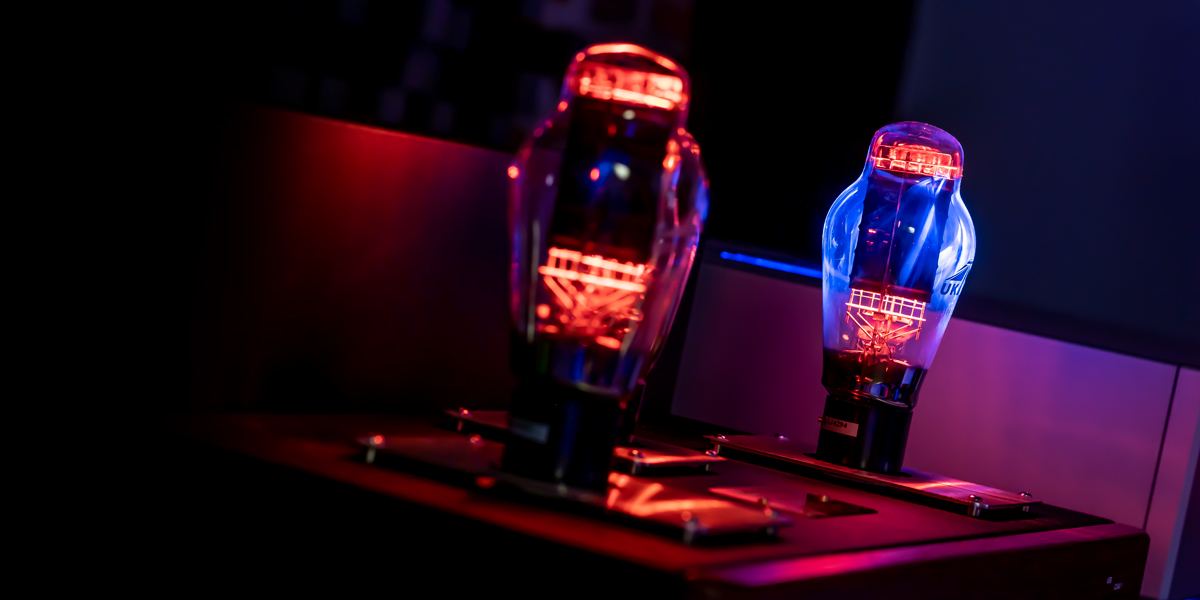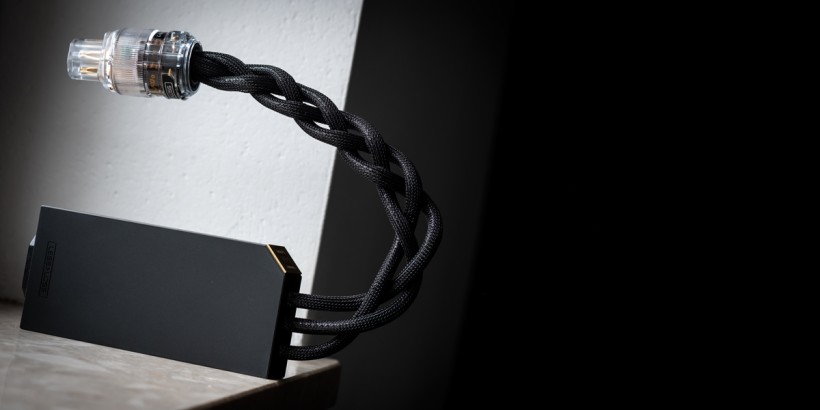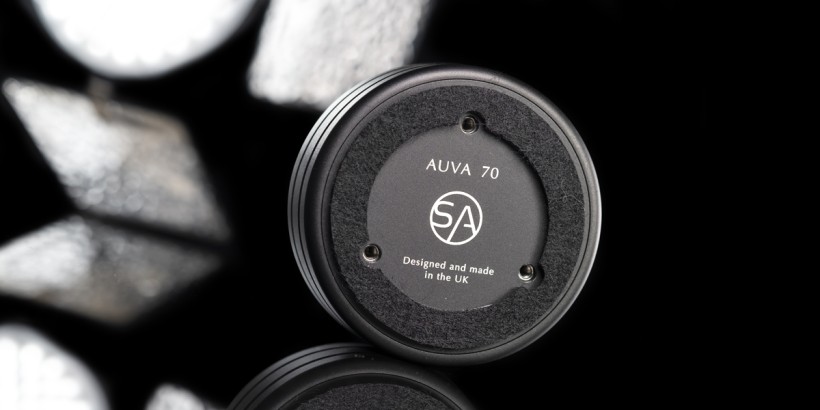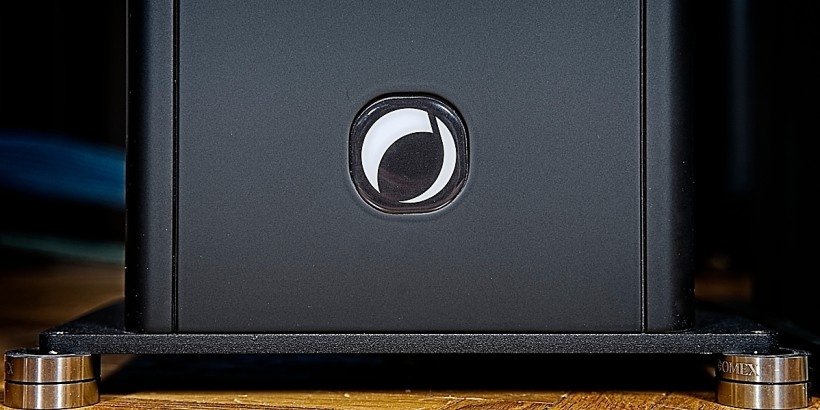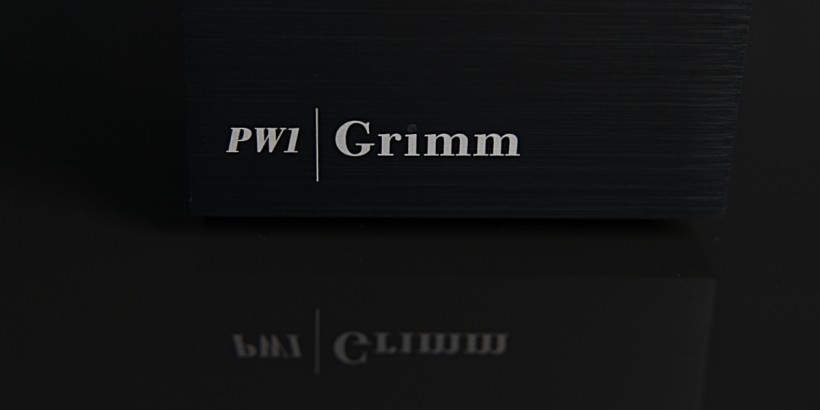Until recently, the local company Audio Reveal had exclusively tube integrated amplifiers in its lineup. Earlier this year a very unusual DAC – Audio Reveal Hercules – joined the gang. Now it’s time to take a closer look at this beaut. Enjoy!
Oldtimer
Four years and then some. That’s how long it’s been since I learned about the existence of the local company Audio Reveal. Shortly after I was sent its integrated amplifier simply named Second. This classy machine was styled to impress tube aficionados and infused with KT150s. Its maker Michał Posiewka applied these beam tetrodes in the good ‘ol purist single-ended class A circuit, where each channel gets only one device. Interestingly, the man traded in some of the useful output power of the KT150s for their longer life span. 20wpc into 8Ω didn’t seem like much early on, but the Second proved highly competent on audible control, might and traction. I also think that this integrated amp would make a similar impression on me today.
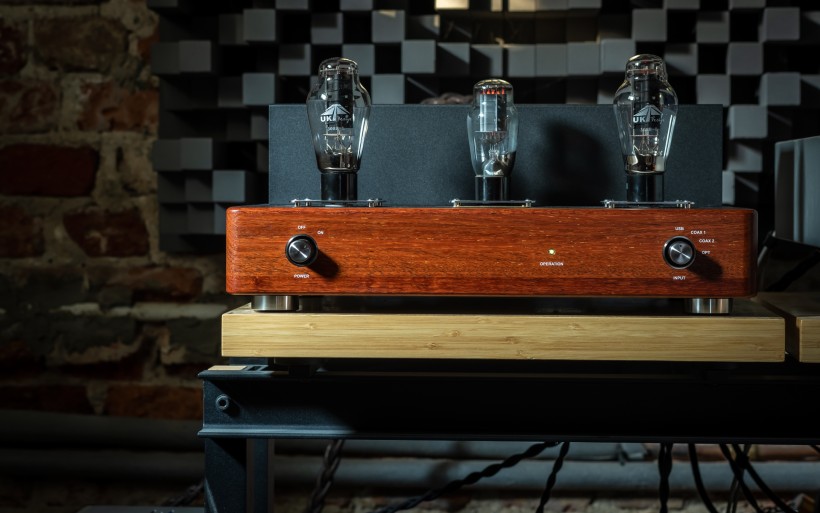 Officially established in 2018, Audio Reveal is a relatively new company. Michał Posiewka’s designs however suggest otherwise, as if he’s been in the business much longer. Many newcomer establishments often release hardware with minor or major shortcomings here and there. Audio Reveal Second loaner delivered to me in June 2020 was made perfectly; silent, mechanically rigid, predictable under stress and assembled with tight tolerances. Every little detail was sorted. The sensation of a luxurious product built to last was there and any reasons to complain were left at the door. I mention this because it’s important. Whether we like it or not, we also buy this stuff with our eyes. Speaking of, Audio Reveal’s aesthetically conservative roster isn’t for those who fancy machined aluminum-based minimalism, yet speaks volume to those who understand that a massive base armed with exposed transformer cups and tubes are essentials without any real alternatives. Michał simply makes products mainly for such audience and in style he personally enjoys. Gracefully lit up tubes happen to be their indispensable and eye-pleasing element. If there’s no need to reinvent the wheel, don’t. That’s the smart play. All things considered, I’ll be very surprised if Michał ever creates a transistor device.
Officially established in 2018, Audio Reveal is a relatively new company. Michał Posiewka’s designs however suggest otherwise, as if he’s been in the business much longer. Many newcomer establishments often release hardware with minor or major shortcomings here and there. Audio Reveal Second loaner delivered to me in June 2020 was made perfectly; silent, mechanically rigid, predictable under stress and assembled with tight tolerances. Every little detail was sorted. The sensation of a luxurious product built to last was there and any reasons to complain were left at the door. I mention this because it’s important. Whether we like it or not, we also buy this stuff with our eyes. Speaking of, Audio Reveal’s aesthetically conservative roster isn’t for those who fancy machined aluminum-based minimalism, yet speaks volume to those who understand that a massive base armed with exposed transformer cups and tubes are essentials without any real alternatives. Michał simply makes products mainly for such audience and in style he personally enjoys. Gracefully lit up tubes happen to be their indispensable and eye-pleasing element. If there’s no need to reinvent the wheel, don’t. That’s the smart play. All things considered, I’ll be very surprised if Michał ever creates a transistor device.
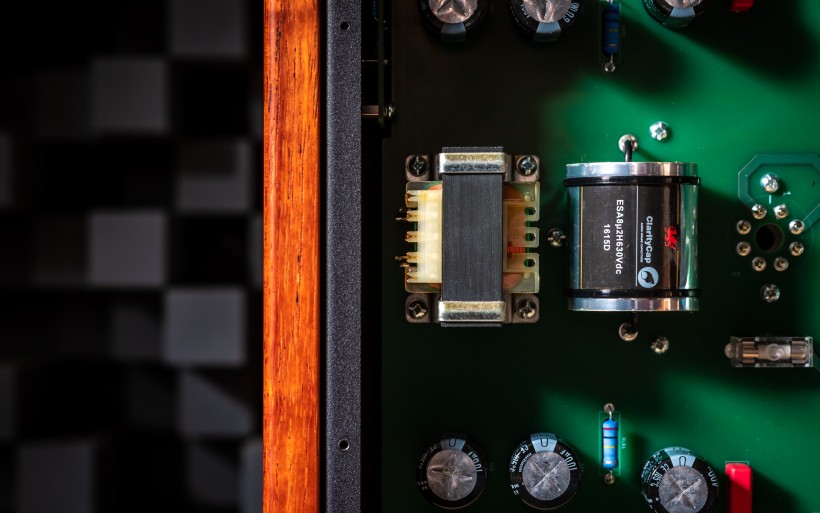 Several months back Audio Reveal’s roster comprised a total of five fairly similar class-A single-ended dual-mono integrated amps. This list opens with Junior (10wpc/8Ω, 2 x 6550), higher up is First (10wpc/8Ω, 2 x KT88) and its improved Mk II version (10wpc/8Ω, 2 x KT88), above which is Second (20wpc/8Ω, 2 x KT150) and its Signature sibling (21wpc/8Ω, 2x KT170) on the very top. If I had to guess the newcomer to this integrated party, either a phono or a twin-box pre/power team would’ve been my picks. Not. Michał took a turn towards the digital land and in March this year released a DAC named Hercules. You’d think of it as a sensible decision and nothing to get excited about per se. The thing is, output DHTs and vintage R-2R bits inside this machine suggest otherwise, and also make it quite the standout on a global scale as far as I can tell.
Several months back Audio Reveal’s roster comprised a total of five fairly similar class-A single-ended dual-mono integrated amps. This list opens with Junior (10wpc/8Ω, 2 x 6550), higher up is First (10wpc/8Ω, 2 x KT88) and its improved Mk II version (10wpc/8Ω, 2 x KT88), above which is Second (20wpc/8Ω, 2 x KT150) and its Signature sibling (21wpc/8Ω, 2x KT170) on the very top. If I had to guess the newcomer to this integrated party, either a phono or a twin-box pre/power team would’ve been my picks. Not. Michał took a turn towards the digital land and in March this year released a DAC named Hercules. You’d think of it as a sensible decision and nothing to get excited about per se. The thing is, output DHTs and vintage R-2R bits inside this machine suggest otherwise, and also make it quite the standout on a global scale as far as I can tell.
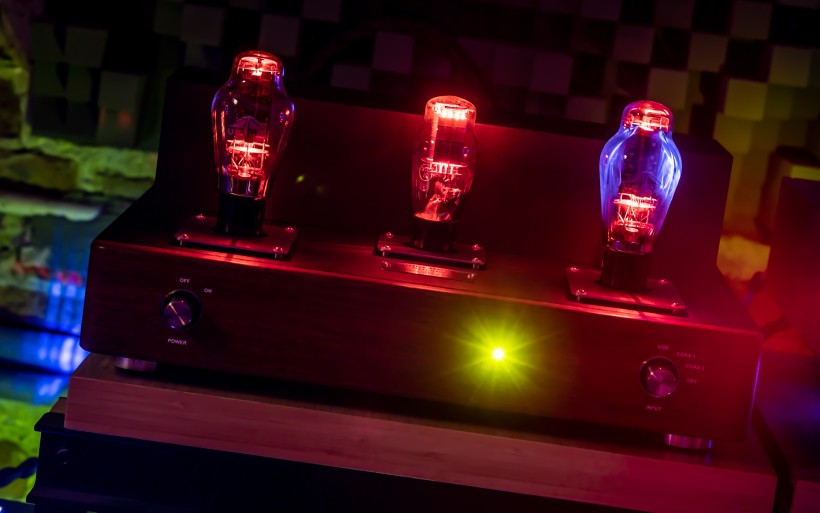 Audio Reveal Hercules was delivered in a double cardboard, which I was able to handle alone. The inner box with several precisely cut foam liners nested the product, gloves and manual. It also had a separate compartment for tubes. The packaging scheme was modest, though practical and generally professional, and the extraction of the key ingredient was easy. Hercules measures (W x H x D) 476 x 410 x 220mm and weighs 16kg, so is large and heavy for a DAC yet perfectly manageable by one adult. The manufacturer’s specs list 20Hz – 20kHz frequency response, 2.7V output voltage and 95W power draw. The USB input supports data up to 24-bit/384kHz, while the available S/PDIF inputs follow their specs and handle signal up to 24-bit/192kHz. The vintage R-2R chip used in the Hercules works only with PCM data, which means that tracks natively recorded in DSD will result in nothing but noise. Many people may see this as a major con. I don’t. DSD music is less than 2% of my collection. These days many streamers can convert DSD to PCM on the fly prior to sending it out, i.e. those which incorporate Roon, and the problem with 1-bit playback is less severe than years back. On a more positive note, Michał is working on a ΔΣ engine that will support native DSD, so in the future Hercules will be available either with a vintage or modern digital board. When that turns into reality, I intend to compare the two versions and update this article.
Audio Reveal Hercules was delivered in a double cardboard, which I was able to handle alone. The inner box with several precisely cut foam liners nested the product, gloves and manual. It also had a separate compartment for tubes. The packaging scheme was modest, though practical and generally professional, and the extraction of the key ingredient was easy. Hercules measures (W x H x D) 476 x 410 x 220mm and weighs 16kg, so is large and heavy for a DAC yet perfectly manageable by one adult. The manufacturer’s specs list 20Hz – 20kHz frequency response, 2.7V output voltage and 95W power draw. The USB input supports data up to 24-bit/384kHz, while the available S/PDIF inputs follow their specs and handle signal up to 24-bit/192kHz. The vintage R-2R chip used in the Hercules works only with PCM data, which means that tracks natively recorded in DSD will result in nothing but noise. Many people may see this as a major con. I don’t. DSD music is less than 2% of my collection. These days many streamers can convert DSD to PCM on the fly prior to sending it out, i.e. those which incorporate Roon, and the problem with 1-bit playback is less severe than years back. On a more positive note, Michał is working on a ΔΣ engine that will support native DSD, so in the future Hercules will be available either with a vintage or modern digital board. When that turns into reality, I intend to compare the two versions and update this article.
 Audio Reveal Hercules is a vanilla DAC without any modern bells and whistles; volume control, upsampling, wireless input or network component. I’m not surprised in the slightest, Michał himself is a purist. Each his product does only one core task and that’s it. Hercules fits that profile so is a niche design by today’s standards, while its topology further reinforces this status. DACs with tubes in their output stages are rare. Those with DHTs even more so. Manufacturers into this stuff are few and far between. Lampizator is probably the most known for such designs. The most affordable DHT DAC in this roster – Golden Gate 3 – demands €18’500. Hercules as reviewed (2x Psvane UK300B ‘UK Design’ and a Russian NOS 5U4G rectifier) costs €10’900. Emission Labs mesh 300Bs and 5U4G add €1’100 to the bill. In the grand scheme this is an expensive product. However, if we take into account DHT DACs only by well-established businesses and leave out DIY projects, this one seems to be the most affordable among its elite niche kind. To my knowledge this also is the only such a platform with NOS R-2R chips on board. That’s what I meant when I described it as a global standout. Michał wasn’t even aware of this. During one of our recent convos he said that to his ears old multibit DACs sound great. Output 300Bs were a better match for his R-2Rs of choice than 6SN7 dual triodes that the Hercules project started with. The rest is history.
Audio Reveal Hercules is a vanilla DAC without any modern bells and whistles; volume control, upsampling, wireless input or network component. I’m not surprised in the slightest, Michał himself is a purist. Each his product does only one core task and that’s it. Hercules fits that profile so is a niche design by today’s standards, while its topology further reinforces this status. DACs with tubes in their output stages are rare. Those with DHTs even more so. Manufacturers into this stuff are few and far between. Lampizator is probably the most known for such designs. The most affordable DHT DAC in this roster – Golden Gate 3 – demands €18’500. Hercules as reviewed (2x Psvane UK300B ‘UK Design’ and a Russian NOS 5U4G rectifier) costs €10’900. Emission Labs mesh 300Bs and 5U4G add €1’100 to the bill. In the grand scheme this is an expensive product. However, if we take into account DHT DACs only by well-established businesses and leave out DIY projects, this one seems to be the most affordable among its elite niche kind. To my knowledge this also is the only such a platform with NOS R-2R chips on board. That’s what I meant when I described it as a global standout. Michał wasn’t even aware of this. During one of our recent convos he said that to his ears old multibit DACs sound great. Output 300Bs were a better match for his R-2Rs of choice than 6SN7 dual triodes that the Hercules project started with. The rest is history.
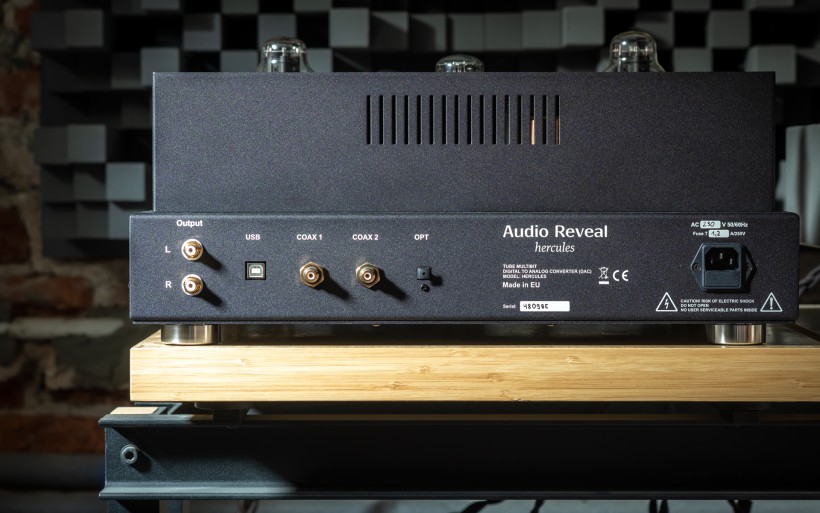 Audio Reveal Hercules looks the way it does for two reasons. One, it was made to visually match its integrated siblings. Two, the key components inside it require a lot of space for comfortable working conditions. To kill two birds with one stone, Michał repurposed the enclosure of his Second integrated amp for this project. The forehead built upon thick merbau insert is modest yet features all the necessary bits. A steel knob on the right cycles through digital inputs, while its counterpart on the left is the main on/off switch. A green LED in that area blinks for a minute during the soft-start procedure and stays engaged when it’s done. Normally I’d consider the lack of a remote wand in the set as a drawback. Hercules has no volume control and other functions beyond the two basic utilities (on/off and input selection), so this wasn’t an issue for me. The product sits on four aluminum feet with rubber O-rings, while its business end from left to right houses a pair of RCA outs, five digital inputs (a USB, 2x coax S/PDIF and 2x optical S/PDIF) and a fused IEC inlet.
Audio Reveal Hercules looks the way it does for two reasons. One, it was made to visually match its integrated siblings. Two, the key components inside it require a lot of space for comfortable working conditions. To kill two birds with one stone, Michał repurposed the enclosure of his Second integrated amp for this project. The forehead built upon thick merbau insert is modest yet features all the necessary bits. A steel knob on the right cycles through digital inputs, while its counterpart on the left is the main on/off switch. A green LED in that area blinks for a minute during the soft-start procedure and stays engaged when it’s done. Normally I’d consider the lack of a remote wand in the set as a drawback. Hercules has no volume control and other functions beyond the two basic utilities (on/off and input selection), so this wasn’t an issue for me. The product sits on four aluminum feet with rubber O-rings, while its business end from left to right houses a pair of RCA outs, five digital inputs (a USB, 2x coax S/PDIF and 2x optical S/PDIF) and a fused IEC inlet.
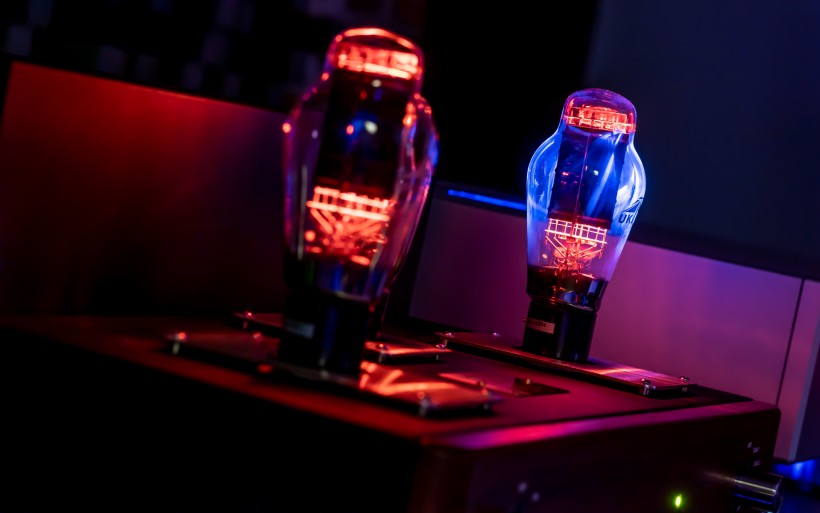 Today’s 2mm-thick powder-coated steel enclosure is generously perforated and slightly rounded here and there. Openings inside two gently raised silver plates on the bonnet accommodate DHTs, a rectifier tube goes in-between these. The elegant gold-plated nameplate just a hair below details what kind of a rare specimen Hercules is. A large protruding compartment for transformers behind the tubes results in visual seriousness and amp-like aesthetics. Hercules in the flesh and on the shelf feels and looks better than the tube routine its shots imply. Only up close we can see how expertly the steel inserts have been inlaid into the exquisitely machined wood front, and how well individual chassis components fit one another. The view inside is no less impressive. The digital board houses Amanero Combo384 USB receiver, and just below we find the multibit heart under a large acrylic screen. Its size suggests more than one R-2R unit, but I promised to not say a word beyond that. The main PCB almost as large as the enclosure base itself houses a small EI transformer used as a choke, while two larger units of the same type power the digital and analog sections separately. All were made by the local EI transformer guru, Leszek Ogonowski. The filtering capacitors are by Epcos and Nichicon, while those responsible for coupling are by Clarity Cap. Michał is an electronics engineer with thirty years of experience and a perfectionist. I think that Hercules communicates this very clearly both inside and out.
Today’s 2mm-thick powder-coated steel enclosure is generously perforated and slightly rounded here and there. Openings inside two gently raised silver plates on the bonnet accommodate DHTs, a rectifier tube goes in-between these. The elegant gold-plated nameplate just a hair below details what kind of a rare specimen Hercules is. A large protruding compartment for transformers behind the tubes results in visual seriousness and amp-like aesthetics. Hercules in the flesh and on the shelf feels and looks better than the tube routine its shots imply. Only up close we can see how expertly the steel inserts have been inlaid into the exquisitely machined wood front, and how well individual chassis components fit one another. The view inside is no less impressive. The digital board houses Amanero Combo384 USB receiver, and just below we find the multibit heart under a large acrylic screen. Its size suggests more than one R-2R unit, but I promised to not say a word beyond that. The main PCB almost as large as the enclosure base itself houses a small EI transformer used as a choke, while two larger units of the same type power the digital and analog sections separately. All were made by the local EI transformer guru, Leszek Ogonowski. The filtering capacitors are by Epcos and Nichicon, while those responsible for coupling are by Clarity Cap. Michał is an electronics engineer with thirty years of experience and a perfectionist. I think that Hercules communicates this very clearly both inside and out.
 I enjoy testing DACs for several reasons. Firstly, they are easier to get around than, say, most speakers or amps. Secondly, moving between them is quick and easy. Just unplug the USB cable from one unit, connect it into the other, remotely change the input on your preamp and you’re done. Most streamers instantly recognize USB receivers, so there’s no need to turn off anything. Thirdly, at my place differences between DACs are usually very audible. This time around the result wasn’t any different. Both the Hercules and my Lampizator Pacific saw the same power cords (Boenicke M2) and Boenicke Power Gate distributor, while LessLoss C-MARC RCAs connected them to the Trilogy 915R preamplifier. The battlefield was nicely leveled. The use of identical tube sets in both compared machines would make it even better, but that luxury was off the table. The LV300B triodes and the KR Audio 5U4G rectifier refuse to grow on trees. To overcome this, the two compared DACs simply swapped their glowing bits, so their input was possible to separate from the rest. All in all, it was worth the hassle. Then the Hercules presented itself from an audibly different side.
I enjoy testing DACs for several reasons. Firstly, they are easier to get around than, say, most speakers or amps. Secondly, moving between them is quick and easy. Just unplug the USB cable from one unit, connect it into the other, remotely change the input on your preamp and you’re done. Most streamers instantly recognize USB receivers, so there’s no need to turn off anything. Thirdly, at my place differences between DACs are usually very audible. This time around the result wasn’t any different. Both the Hercules and my Lampizator Pacific saw the same power cords (Boenicke M2) and Boenicke Power Gate distributor, while LessLoss C-MARC RCAs connected them to the Trilogy 915R preamplifier. The battlefield was nicely leveled. The use of identical tube sets in both compared machines would make it even better, but that luxury was off the table. The LV300B triodes and the KR Audio 5U4G rectifier refuse to grow on trees. To overcome this, the two compared DACs simply swapped their glowing bits, so their input was possible to separate from the rest. All in all, it was worth the hassle. Then the Hercules presented itself from an audibly different side.
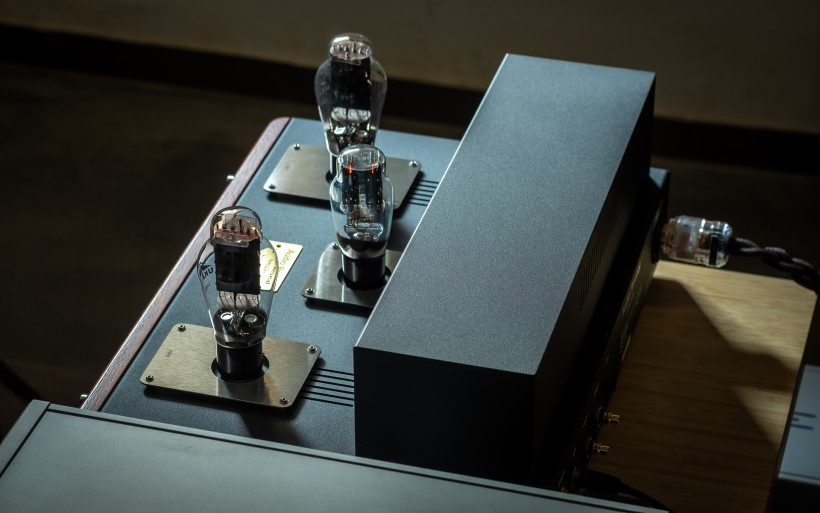 Audio Reveal Hercules largely sounds the way it looks, so in “the good ‘ol way” and in a positive sense. That was expected. Not that I’ve looked into a crystal ball, I’m no fortune teller. The enormous potential of this Polish DAC has to be experienced of course, rest assured there’s a lot to experience and intake, but its topology already tells us quite a bit about its behavior. The digital heart of the Hercules belongs to a family of ICs with several well-pronounced sonic features, or at least that’s what my experience tells me. Such products with the old R-2Rs and their modern discrete counterparts presented music in an elegant, pleasantly physiological and soft fashion, and also kept extreme magnification at bay. This is quite an oversimplification that demands explanations. Let’s then assume that a fast, lean, ethereal, open, distant, detailed, cool, contoured, hard and bright sound occupies one end of the scale, while the other has voicing built upon darkness, density, warmth, roundness, softness and spatial intimacy. In this context, multibit DACs are closer to the latter. However, warmth, density, softness and intimacy shape their sound to a much lesser degree than elasticity, tonal richness, dynamics, tactility and that fine organic flavor which results from these qualities. This particular trait in my glossary unfolds into a specific tissue on instruments and vocals that boosts their mass, adds color and rounds out their outlines a bit, but also makes them as nimble and vivid as they are substantial, moist, palpable and easy to intake. The organic charm in question is not the same as just plain warmth and density, which even slightly overdone screw up agility and expressiveness, steal oxygen and kill particles floating in the air. The difference is fundamental, though not exactly easy to put into words. Listening is the only way to fully grasping what I’m on about here. Let’s just say that R-2R DACs are inherently a bit dense, but not overly sweet, bulky and ultimately unclear. I find their sound aromatic, expressive, resolving, moist and structurally complex instead. Audio Reveal Hercules has these traits in spades. More importantly, it charms with them in such a way that the world around us becomes irrelevant. Last time I checked, that was the main goal of this hobby.
Audio Reveal Hercules largely sounds the way it looks, so in “the good ‘ol way” and in a positive sense. That was expected. Not that I’ve looked into a crystal ball, I’m no fortune teller. The enormous potential of this Polish DAC has to be experienced of course, rest assured there’s a lot to experience and intake, but its topology already tells us quite a bit about its behavior. The digital heart of the Hercules belongs to a family of ICs with several well-pronounced sonic features, or at least that’s what my experience tells me. Such products with the old R-2Rs and their modern discrete counterparts presented music in an elegant, pleasantly physiological and soft fashion, and also kept extreme magnification at bay. This is quite an oversimplification that demands explanations. Let’s then assume that a fast, lean, ethereal, open, distant, detailed, cool, contoured, hard and bright sound occupies one end of the scale, while the other has voicing built upon darkness, density, warmth, roundness, softness and spatial intimacy. In this context, multibit DACs are closer to the latter. However, warmth, density, softness and intimacy shape their sound to a much lesser degree than elasticity, tonal richness, dynamics, tactility and that fine organic flavor which results from these qualities. This particular trait in my glossary unfolds into a specific tissue on instruments and vocals that boosts their mass, adds color and rounds out their outlines a bit, but also makes them as nimble and vivid as they are substantial, moist, palpable and easy to intake. The organic charm in question is not the same as just plain warmth and density, which even slightly overdone screw up agility and expressiveness, steal oxygen and kill particles floating in the air. The difference is fundamental, though not exactly easy to put into words. Listening is the only way to fully grasping what I’m on about here. Let’s just say that R-2R DACs are inherently a bit dense, but not overly sweet, bulky and ultimately unclear. I find their sound aromatic, expressive, resolving, moist and structurally complex instead. Audio Reveal Hercules has these traits in spades. More importantly, it charms with them in such a way that the world around us becomes irrelevant. Last time I checked, that was the main goal of this hobby.
 I’m aware that this may read a touch lofty, but Hercules is for music enthusiasts who, when they turn on their systems, want to end up in an enchanted realm where the vibe is nice, pleasant and peaceful. Here this DAC fares exceptionally well, but only. Its multibit part is an excellent base for DHTs, which boast quite a few very desirable traits when applied to such products. These tubes are the very reason to strap your seatbelts, hold on to your seat and sweat. Their kind used mainly in amplifiers is valued for its euphonic character, timbre and similar things, but applied in a DAC they yield something different and equally interesting. Therein DHTs also manifest conventionally sensual qualities, because why not, but at the same time they boost the sound of the base platform with additional provisions of dynamics, openness, agility, hardness, power and feistiness. To simplify, directly-heated triodes in DACs make them highly euphonic and sporty. The differences between these DHTs (…and 5U4Gs as well to an extent) will determine the primary direction by leaning towards one trait group more than the other, but tube flavor on some serious steroids will be the common ground no matter the choice. For the record, my two previous Lampizators (Level 7, Golden Gate) and the currently owned Pacific are the reference points here, which also have a lot in common with the Hercules, so it’s not surprising that this one was a perfect fit for my taste. This is why Michał’s decision to spice up the digital part of this machine with large triodes was a spot on decision to me.
I’m aware that this may read a touch lofty, but Hercules is for music enthusiasts who, when they turn on their systems, want to end up in an enchanted realm where the vibe is nice, pleasant and peaceful. Here this DAC fares exceptionally well, but only. Its multibit part is an excellent base for DHTs, which boast quite a few very desirable traits when applied to such products. These tubes are the very reason to strap your seatbelts, hold on to your seat and sweat. Their kind used mainly in amplifiers is valued for its euphonic character, timbre and similar things, but applied in a DAC they yield something different and equally interesting. Therein DHTs also manifest conventionally sensual qualities, because why not, but at the same time they boost the sound of the base platform with additional provisions of dynamics, openness, agility, hardness, power and feistiness. To simplify, directly-heated triodes in DACs make them highly euphonic and sporty. The differences between these DHTs (…and 5U4Gs as well to an extent) will determine the primary direction by leaning towards one trait group more than the other, but tube flavor on some serious steroids will be the common ground no matter the choice. For the record, my two previous Lampizators (Level 7, Golden Gate) and the currently owned Pacific are the reference points here, which also have a lot in common with the Hercules, so it’s not surprising that this one was a perfect fit for my taste. This is why Michał’s decision to spice up the digital part of this machine with large triodes was a spot on decision to me.
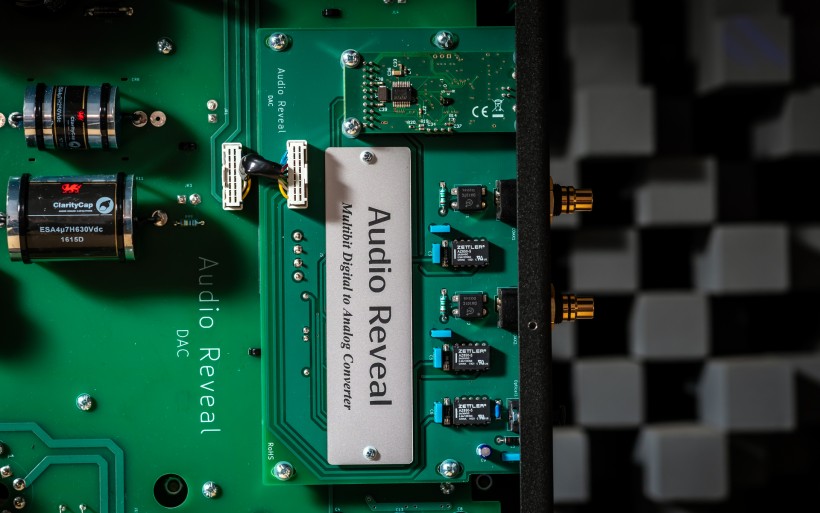 The above makes the Hercules an outstanding device no less, and mainly because it perfectly combines qualities meant to show music from an engaging, appetizing and thoroughly enjoyable side with those that make it lively, direct and intense. However the repertoire will dictate the main angle, this DAC will brilliantly adapt to it. While this does not affect its evaluation, I should mention that Hercules offers a set of features that I fell in love with years ago and still cling to. In many ways it sounds differently than the Pacific, but that doesn’t steal anything away from it. On the contrary, the former has its own agenda. It presents each music type from an incredibly atmospheric angle. Here I mean its ability to highlight the most important elements of specific tracks and smoothly transition between them. I see this as one of today’s strongest suits in fact. A single vocal line in assistance of a a small drum is basically the entirety of Rhiannon Giddens’ “Little Margaret” cover. For most of the time her voice has our attention, but the increasingly eratic instrumental beats steal it as time goes by. What matters here is the heavy, intense, tense atmosphere that reflects the rather somber lyrics. The Hercules showed this grim mood flawlessly, better than my reference and partly because the latter’s tuning is brighter. I observed and felt something similar while listening to Nick Cave’s “Hand of God” and several other songs, in which heightened anxiety and the associated sense of pleasant discomfort are essential ingredients. On such fare Hercules brilliantly toyed with my emotions and was higly evocative. I respect that.
The above makes the Hercules an outstanding device no less, and mainly because it perfectly combines qualities meant to show music from an engaging, appetizing and thoroughly enjoyable side with those that make it lively, direct and intense. However the repertoire will dictate the main angle, this DAC will brilliantly adapt to it. While this does not affect its evaluation, I should mention that Hercules offers a set of features that I fell in love with years ago and still cling to. In many ways it sounds differently than the Pacific, but that doesn’t steal anything away from it. On the contrary, the former has its own agenda. It presents each music type from an incredibly atmospheric angle. Here I mean its ability to highlight the most important elements of specific tracks and smoothly transition between them. I see this as one of today’s strongest suits in fact. A single vocal line in assistance of a a small drum is basically the entirety of Rhiannon Giddens’ “Little Margaret” cover. For most of the time her voice has our attention, but the increasingly eratic instrumental beats steal it as time goes by. What matters here is the heavy, intense, tense atmosphere that reflects the rather somber lyrics. The Hercules showed this grim mood flawlessly, better than my reference and partly because the latter’s tuning is brighter. I observed and felt something similar while listening to Nick Cave’s “Hand of God” and several other songs, in which heightened anxiety and the associated sense of pleasant discomfort are essential ingredients. On such fare Hercules brilliantly toyed with my emotions and was higly evocative. I respect that.
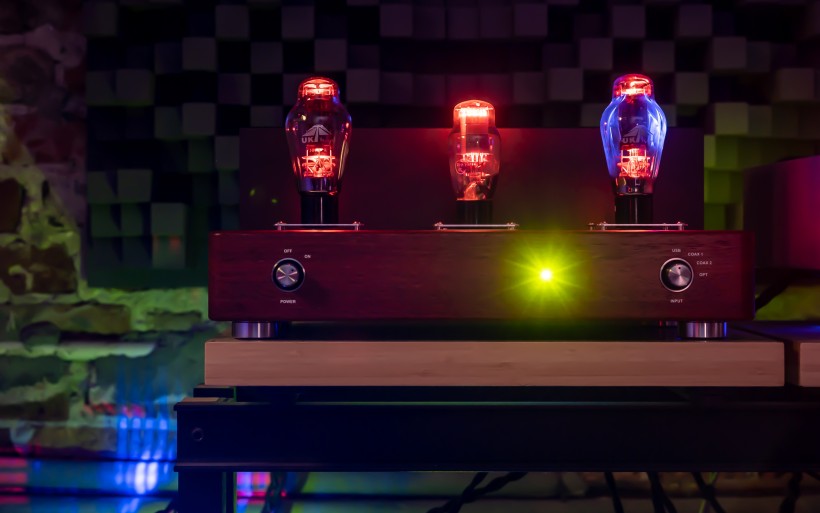 In my listening room, the Hercules did not have it easy. The KR Audio 5U4G rectifier and LV300B tubes make my reference DAC exceptionally insightful, open, immediate, athletic, contoured, direct and loaded with adrenaline. The short distance to the key virtual outlines makes them ‘visibly’ larger and inside a gorgeously aerated and layer wise complex sphere. A listener positioned near the middle of it is exposed to the awesome here and now experience. While the LV300B buffers partake in making my DAC satisfyingly hefty, smooth and colorful, they also build its sunny, shiny, majestic and electrifying personality. The Hercules with basic tubes on board played more distantly and calmer. Its tonal center of gravity was lower, while the emphasis was on color, density, thicker virtual contours and my attention on those present between the speakers. The effect was mellower, softer, somewhat dreamier and mainly geared towards relaxation and flow, though also superb in terms of instrumental and vocal articulation, overall clarity and openness. This is precisely what I meant by describing today’s sound as done “the old way”. At its core, this voicing is groomed to squeeze a tear or two and keep fatigue at the door even after many hours of listening.
In my listening room, the Hercules did not have it easy. The KR Audio 5U4G rectifier and LV300B tubes make my reference DAC exceptionally insightful, open, immediate, athletic, contoured, direct and loaded with adrenaline. The short distance to the key virtual outlines makes them ‘visibly’ larger and inside a gorgeously aerated and layer wise complex sphere. A listener positioned near the middle of it is exposed to the awesome here and now experience. While the LV300B buffers partake in making my DAC satisfyingly hefty, smooth and colorful, they also build its sunny, shiny, majestic and electrifying personality. The Hercules with basic tubes on board played more distantly and calmer. Its tonal center of gravity was lower, while the emphasis was on color, density, thicker virtual contours and my attention on those present between the speakers. The effect was mellower, softer, somewhat dreamier and mainly geared towards relaxation and flow, though also superb in terms of instrumental and vocal articulation, overall clarity and openness. This is precisely what I meant by describing today’s sound as done “the old way”. At its core, this voicing is groomed to squeeze a tear or two and keep fatigue at the door even after many hours of listening.
 It is said that standard tubes in DACs are just placeholders for their fancier and pricier equivalents. However, in case of the Hercules I’d wait with any such changes, mainly because its stock tube set marvelously supported its inherent multibit character, as if by using this specific glass arsenal Michał wanted to communicate what kind of sound he was after. I didn’t ask so am only guessing here, but this was my impression after transferring the rectifier and DHTs from my reference to the Hercules. Then the latter sounded noticeably faster, more firm, illuminated, energetic, spatially expansive and more open. It also rendered all virtual outlines closer, was dynamically wider and slammed harder. The scales audibly tipped toward increased clarity, momentum, flexibility and spatial presence with the increased sensation of movement there, thus athletic clearly sporty qualities, albeit without any compromises on high-tiered timbre, euphony or smoothness. The Hercules gained a lot of extra horsepower and simply got significantly better, but also a touch leaner, while a bit of its fetching atmospheric heaviness and darkness evaporated. I mention this to emphasize that this wasn’t a case of exclusive gains. It rarely is, but no matter. Hercules with basic tubes already sounded so engagingly and endearingly that for most of its stay at my place I just didn’t bother changing them. When that day finally came, Michał’s DAC got closer to the Pacific’s profile yet still retained a fair share of its multibit charm. Just to be clear, DHTs make quite an impact and rolling them is a major adventure on its own two legs. I highly recommend doing so, but not before getting properly accustomed to today’s starter tubes. In Hercules they’re worth your attention, that’s for sure.
It is said that standard tubes in DACs are just placeholders for their fancier and pricier equivalents. However, in case of the Hercules I’d wait with any such changes, mainly because its stock tube set marvelously supported its inherent multibit character, as if by using this specific glass arsenal Michał wanted to communicate what kind of sound he was after. I didn’t ask so am only guessing here, but this was my impression after transferring the rectifier and DHTs from my reference to the Hercules. Then the latter sounded noticeably faster, more firm, illuminated, energetic, spatially expansive and more open. It also rendered all virtual outlines closer, was dynamically wider and slammed harder. The scales audibly tipped toward increased clarity, momentum, flexibility and spatial presence with the increased sensation of movement there, thus athletic clearly sporty qualities, albeit without any compromises on high-tiered timbre, euphony or smoothness. The Hercules gained a lot of extra horsepower and simply got significantly better, but also a touch leaner, while a bit of its fetching atmospheric heaviness and darkness evaporated. I mention this to emphasize that this wasn’t a case of exclusive gains. It rarely is, but no matter. Hercules with basic tubes already sounded so engagingly and endearingly that for most of its stay at my place I just didn’t bother changing them. When that day finally came, Michał’s DAC got closer to the Pacific’s profile yet still retained a fair share of its multibit charm. Just to be clear, DHTs make quite an impact and rolling them is a major adventure on its own two legs. I highly recommend doing so, but not before getting properly accustomed to today’s starter tubes. In Hercules they’re worth your attention, that’s for sure.
Summary
There is no shortage of very good and affordable DACs on the market. Denafrips, Laiv and Holo stress that point very well. Against their kind Audio Reveal Hercules may seem like a painfully expensive functionally modest niche relic without raison d’être in today’s world. No matter. This affair neither competes with modern trends not it has to. It was designed to execute one task only, but with character, class and rare means, which remain outside the digital mainstream’s scope and demand far more inside topologically similar competitors. Audio Reveal Hercules accomplishes its core mission masterfully. It stands tall as fantastic where it matters, luxurious, unique and priced accordingly to what it represents and delivers. As a fan of the breed, I’m very glad it was made and also very impressed. If you are big on DHT-infused twists in the digital domain, you will be too.
Update
In mid December, Michał Posiewka reached out with some good news about his Hercules . The man not only was ready with the ΣΔ board for this DAC, but he already had it installed in several units. One such a newcomer awaited me at his local dealer’s store some 10 kilometers away from my listening place. It looked like a quick and easy job just before holiday, so I was game. Prior to moving forward let me first explain the basics. Upon ordering Audio Reveal DAC, paying customers get to decide which digital engine of the following two they’d like to have; either the first version built upon R-2R bits, or the latest circuit based on an undisclosed ΣΔ D/A conversion chip. Both rock Amanero USB receivers, which are compatible with pretty much every streamer available on the market. The entire power supply, output stage and enclosure also remain the same. The new model has a slightly different writing on the brass placard in the tube area and also a small sticker that covers silkscreen letters on the rear. These minor things make the only visual differences between the two Hercules types, which unsurprisingly operate the same. The primary disparity between them is in the new version’s ability to natively handle DSD music. This utility is one of the two kay reasons why it was made in the first place, while the new engine’s different sonic profile is the other. The goal of this update is to explain all the changes it packs. Considering the above, the choice between the old and new Hercules should theoretically narrow down to music one listens to the most. Those who listen only to DSD, and I know quite a few people quite fanatical about this format, have only one option. Although I appreciate DSD for sound quality, at the end of the day it makes less than 5% of my streamer’s entire music warehouse. If my DAC couldn’t play it, I wouldn’t lose sleep over it, but your mileage may vary, so let’s leave this subject and move to the interesting part.
Considering the above, the choice between the old and new Hercules should theoretically narrow down to music one listens to the most. Those who listen only to DSD, and I know quite a few people quite fanatical about this format, have only one option. Although I appreciate DSD for sound quality, at the end of the day it makes less than 5% of my streamer’s entire music warehouse. If my DAC couldn’t play it, I wouldn’t lose sleep over it, but your mileage may vary, so let’s leave this subject and move to the interesting part. I find it extremely interesting that I could directly compare two nearly identical and very expensive DACs. Such opportunities honestly don’t happen every other day. To make the playing field even, the second Hercules loaner had the same tube types installed and more than 100 hours of playback under its belt. The two machines connected to the same power distributor via identical power cables, while alike LessLoss C-MARC RCAs connected them to my 915R. That way to move from one DAC to the other I had to remotely change the input, reconnect a USB cable and that was it. Most importantly, while doing so the two machines were constantly powered on and after each swap my streamer instantly talked to their USB receivers. Now, onto the good stuff.
I find it extremely interesting that I could directly compare two nearly identical and very expensive DACs. Such opportunities honestly don’t happen every other day. To make the playing field even, the second Hercules loaner had the same tube types installed and more than 100 hours of playback under its belt. The two machines connected to the same power distributor via identical power cables, while alike LessLoss C-MARC RCAs connected them to my 915R. That way to move from one DAC to the other I had to remotely change the input, reconnect a USB cable and that was it. Most importantly, while doing so the two machines were constantly powered on and after each swap my streamer instantly talked to their USB receivers. Now, onto the good stuff. Although this is not really relevant, a mere second after the very first swap I chuckled. I thought about those individuals who still think that digital stuff is all the same and doesn’t make an ounce of a difference. I chuckled because I imagined their reactions upon doing the experiment I just did. That would’ve been hilarious, but I digress. Prior to the comparison of the sibling DACs I still had the same expectations as explained above. This is why I expected the ΣΔ version to be the quicker, leaner, snappier, more contoured, direct and spatially more open of the two. That largely wasn’t the case, to a point where I may actually change my stance on the R2R house sound. The new DAC was geared mainly for relaxation, smoothness and high-tiered evenness above all else. What I really want to say is that it checked all the relevant boxes and behaved to high standards all across the board, but neither was it exceptionally gifted or audibly lackluster on any specific front. All in all, I’d call the new Hercules as the more transparent of the two devices. It did well, but its personality in comparison to the older sibling struck me as fair bit more tamed, which left more room for my system’s other components to flaunt their own character.
Although this is not really relevant, a mere second after the very first swap I chuckled. I thought about those individuals who still think that digital stuff is all the same and doesn’t make an ounce of a difference. I chuckled because I imagined their reactions upon doing the experiment I just did. That would’ve been hilarious, but I digress. Prior to the comparison of the sibling DACs I still had the same expectations as explained above. This is why I expected the ΣΔ version to be the quicker, leaner, snappier, more contoured, direct and spatially more open of the two. That largely wasn’t the case, to a point where I may actually change my stance on the R2R house sound. The new DAC was geared mainly for relaxation, smoothness and high-tiered evenness above all else. What I really want to say is that it checked all the relevant boxes and behaved to high standards all across the board, but neither was it exceptionally gifted or audibly lackluster on any specific front. All in all, I’d call the new Hercules as the more transparent of the two devices. It did well, but its personality in comparison to the older sibling struck me as fair bit more tamed, which left more room for my system’s other components to flaunt their own character.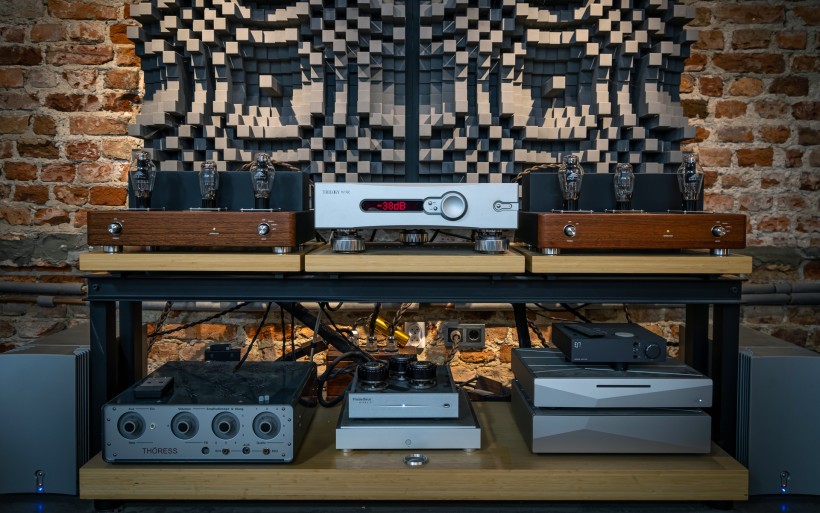 In the context of the new Hercules, its previous version turned out quite fiendish on dynamic span, spatial liberation, agility, heft, authority, directness and overall might. To simplify, the R2R trooper slammed harder and closer, and it also struck me as significantly more intense because of that. As such it brilliantly slotted into the DHT-infused DAC profile that I so dearly enjoy, while the new Hercules far less so. That’s the general lay of the land and the key takeaway. Just to be clear, I’m far from naming the ΣΔ version as any inferior on high-RPM counts such as speed, articulation or willingness to rock hard. Not at all. This one does the job perfectly fine here, but its calmer, less pronounced and largely balanced personality mainly aims to please by adaptation rather than off-script stunts. Systems which already are plenty quick and intense may find that very useful. If DSD is most of what they do, even more so. Meanwhile, as a sucker for the usual DHT DAC voicing built upon immediacy, intensity and that sort of wickedness, I’d go for the R2R Hercules without thinking twice.
In the context of the new Hercules, its previous version turned out quite fiendish on dynamic span, spatial liberation, agility, heft, authority, directness and overall might. To simplify, the R2R trooper slammed harder and closer, and it also struck me as significantly more intense because of that. As such it brilliantly slotted into the DHT-infused DAC profile that I so dearly enjoy, while the new Hercules far less so. That’s the general lay of the land and the key takeaway. Just to be clear, I’m far from naming the ΣΔ version as any inferior on high-RPM counts such as speed, articulation or willingness to rock hard. Not at all. This one does the job perfectly fine here, but its calmer, less pronounced and largely balanced personality mainly aims to please by adaptation rather than off-script stunts. Systems which already are plenty quick and intense may find that very useful. If DSD is most of what they do, even more so. Meanwhile, as a sucker for the usual DHT DAC voicing built upon immediacy, intensity and that sort of wickedness, I’d go for the R2R Hercules without thinking twice.
Associated Equipment:
- Amplifier: Trilogy 995R, FirstWatt F7, Enleum AMP-23R
- DAC: LampizatOr Pacific (KR Audio T-100 / Living Voice 300B + KR Audio 5U4G Ltd. Ed.)
- Speakers: Boenicke Audio W11 SE+, sound|kaos Vox 3afw
- Transport: Innuos Statement, fidata HFAS1-S10U
- Preamplifier: Trilogy 915R, Thöress DFP
- Speaker cables: Boenicke Audio S3, LessLoss C-MARC
- Headphones: HifiMan Susvara
- Speaker signal conditioning: LessLoss Firewall for Loudspeakers, Boenicke ComDev
- Anti-vibration conditioning: 6x Carbide Base Diamond (under speakers), 6x Carbide Base Micro Diamond with TwinDamp inserts and spikes (under DAC and pre)
- Interconnects: LessLoss Entropic Process C-MARC, Boenicke Audio IC3 CG
- Power components: Gigawatt PC-3 SE EVO+/LC-3 EVO, LessLoss C-MARC, LessLoss Entropic Process C-MARC, LessLoss Entropic Process C-MARC Stellar, Boenicke Audio Power Gate, ISOL-8 Prometheus, Akiko Audio Triple AC Evolution
- USB components: iFi audio Mercury3.0
- Rack: Franc Audio Accesories Wood Block Rack 1+3
- Network: Fidelizer EtherStream, Linksys WRT160N
- Music: NativeDSD
Retail prices of reviewed components in EU (incl. VAT):
- Audio Reveal Hercules (2x Psvane 300B ‘UK Design’ + Russian NOS 5U4G rectifier): €10’900
- Audio Reveal Hercules (2x EML 300B ‘Mesh’ + EML 5U4G ‘Mesh’) : €12’000
Manufacturer: Audio Reveal



